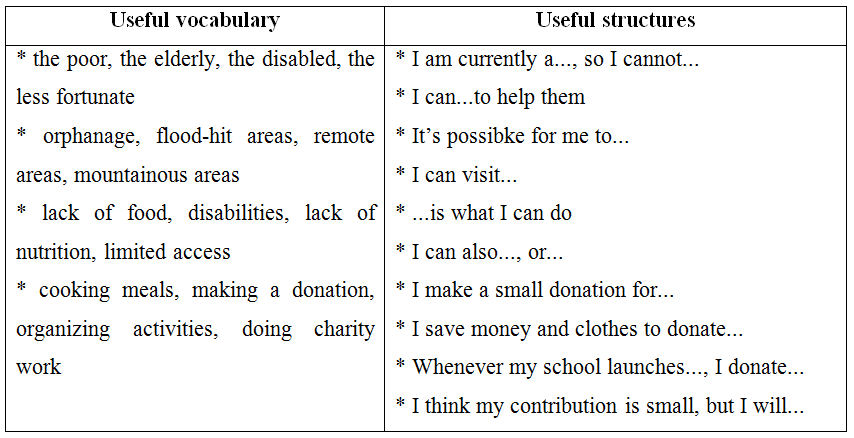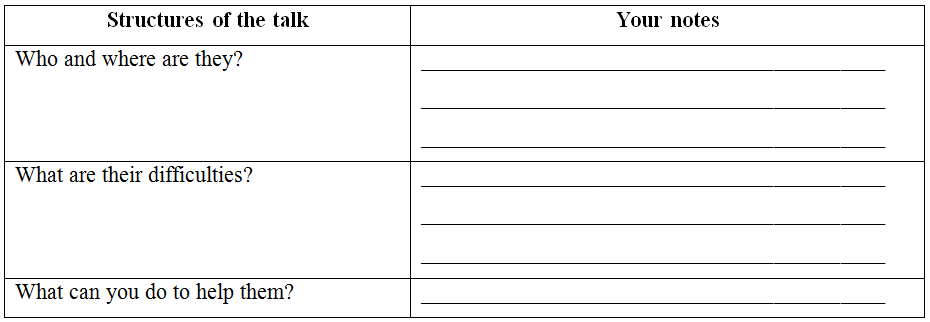Trắc nghiệm Chuyên đề 11 Unit 4. Caring for those in need 1 !!
Câu 1 :
Choose the best option to complete each of the following sentences.
1. People in my neighborhood have_________more than $400 to the charity.
1. People in my neighborhood have_________more than $400 to the charity.
Câu 2 :
2. There should be no_________between disabled children and non-disabled ones.
2. There should be no_________between disabled children and non-disabled ones.
Câu 3 :
3. More and more young people are_________themselves in helping the needy in their country.
Câu 4 :
4. Visually_________children need taking care of better.
4. Visually_________children need taking care of better.
Câu 5 :
5. People should_________as a community regardless of their different backgrounds.
Câu 6 :
6. The United Nations organizes campaigns every year to call for world-wide support for the_________of disabled people.
Câu 7 :
7. It is sad that there are still people who have negative attitudes toward_________people.
Câu 8 :
8. People with cognitive impairments are still_________unfairly.
Câu 9 :
9. She loves to_________to the charity in her mother’s name.
Câu 10 :
10. Why is there still_________between disabled and non-disabled children?
10. Why is there still_________between disabled and non-disabled children?
Câu 11 :
11. We want to know how to support people with_________.
Câu 12 :
12. Australians with physical and mental disabilities have_________violence and abuse at workplaces for years.
12. Australians with physical and mental disabilities have_________violence and abuse at workplaces for years.
Câu 13 :
13. Children from different backgrounds should be_________fairly.
13. Children from different backgrounds should be_________fairly.
Câu 14 :
14. A hearing aid is a great invention to those with_________loss.
Câu 15 :
15. People with physical_________can contribute to the society like any other people.
15. People with physical_________can contribute to the society like any other people.
Câu 16 :
16. There should be no_________to children with disabilities.
Câu 17 :
17. Regardless of different backgrounds, they_________to form a strong community.
17. Regardless of different backgrounds, they_________to form a strong community.
Câu 18 :
18. Instead of saying he is_________, you should say he is unable to speak.
18. Instead of saying he is_________, you should say he is unable to speak.
Câu 19 :
Choose the word or phrase that is CLOSEST in meaning to the underlined part in each of the following sentences.
1. A simple ankle fracture is almost completely healed in 4 weeks.
Choose the word or phrase that is CLOSEST in meaning to the underlined part in each of the following sentences.
Câu 20 :
2. Thev shouldn’t be treated unfairly like that.
Câu 21 :
3. They are holding an auction to raise funds for a charity.
3. They are holding an auction to raise funds for a charity.
A. an organisation that has the purpose of providing money to help people who need it
B. a group of people who work together
C. a person who helps other people willingly and without being paid
Câu 22 :
4. People should learn more about children with cognitive impairments.
4. People should learn more about children with cognitive impairments.
Câu 23 :
5. This entrance is specially designed for people using a wheelchair to access the building.
5. This entrance is specially designed for people using a wheelchair to access the building.
Câu 24 :
6. The theme of this year’s conference is removing barriers to create an inclusive and accessible society for all.
6. The theme of this year’s conference is removing barriers to create an inclusive and accessible society for all.
A. a fence that stops people from going somewhere
B. anything that prevents people from being together
C. a gate in some railway stations
D. a number or measurement
Câu 32 :
Choose the word with the underlined part which can be elided.
Câu 33 :
Choose the word with the underlined part which can be elided.
Câu 34 :
Choose the word with the underlined part which can be elided.
Câu 35 :
Choose the word with the underlined part which can be elided.
Câu 36 :
Choose the word with the underlined part which can be elided.
Câu 37 :
Choose the word with the underlined part which can be elided.
Câu 45 :
8. We have a lovely evening.
8. We have a lovely evening.
Câu 55 :
Choose the best option to complete each of the following sentences.
1. This non-profit organisation_________milk for hundreds of children in this remote area.
1. This non-profit organisation_________milk for hundreds of children in this remote area.
Câu 56 :
2. The Braille alphabet_________invented by a nineteenth-century man named Louis Braille, who was completely blind.
2. The Braille alphabet_________invented by a nineteenth-century man named Louis Braille, who was completely blind.
Câu 57 :
3. He_________blind. He became visually impaired after an accident.
3. He_________blind. He became visually impaired after an accident.
Câu 58 :
4. She_________300 gifts to the charity up to now.
4. She_________300 gifts to the charity up to now.
Câu 59 :
5. She_________part in any voluntary work so far.
5. She_________part in any voluntary work so far.
Câu 60 :
6. At our last meeting, we_________to organize an event for the elderly in the neighbourhood.
6. At our last meeting, we_________to organize an event for the elderly in the neighbourhood.
Câu 61 :
7. When I was a small girl, I_________much time helping disabled friends near my house.
7. When I was a small girl, I_________much time helping disabled friends near my house.
Câu 62 :
8. He has been a volunteer for Youth Blood Donor Organisation_________.
8. He has been a volunteer for Youth Blood Donor Organisation_________.
Câu 63 :
9. He left the army in 1983 and_________as a guard in an orphanage.
9. He left the army in 1983 and_________as a guard in an orphanage.
Câu 64 :
10. Alice_________to work the day before yesterday.
10. Alice_________to work the day before yesterday.
Câu 65 :
11. I first_________her when we were in secondary school.
11. I first_________her when we were in secondary school.
Câu 66 :
12. Up to now, more than 80 countries_________on the Convention.
12. Up to now, more than 80 countries_________on the Convention.
Câu 67 :
13. International Day of Persons with disabilities_________since 1992.
13. International Day of Persons with disabilities_________since 1992.
Câu 68 :
14. The Youth Union in our school_________to launch a campaign to raise funds for the underprivileged.
14. The Youth Union in our school_________to launch a campaign to raise funds for the underprivileged.
Câu 69 :
15. My sister_________home late last night after attending a night party.
15. My sister_________home late last night after attending a night party.
Câu 70 :
16. She_________four novels, and now she is writing the fifth one.
16. She_________four novels, and now she is writing the fifth one.
Câu 71 :
17. I don’t have enough time, so I_________my homework yet.
17. I don’t have enough time, so I_________my homework yet.
Câu 72 :
18. I_________him 5 years ago at our friend’s wedding.
18. I_________him 5 years ago at our friend’s wedding.
Câu 73 :
19. The little girl_________a thousand paper cranes so far.
19. The little girl_________a thousand paper cranes so far.
Câu 74 :
20. My class visited a special school_________.
20. My class visited a special school_________.
Câu 75 :
21. He_________blood 3 times since he attended university.
21. He_________blood 3 times since he attended university.
Câu 76 :
22. I know you are busy but you_________your homework yet?
22. I know you are busy but you_________your homework yet?
Câu 77 :
23. When I was a kid, I_________to share my bedroom with my sister, but now I need more privacy.
23. When I was a kid, I_________to share my bedroom with my sister, but now I need more privacy.
Câu 78 :
24. Everyone noticed that he_________to be sympathetic in the last meeting.
24. Everyone noticed that he_________to be sympathetic in the last meeting.
Câu 79 :
25. When I was 5 years old, I_________to church for the first time.
25. When I was 5 years old, I_________to church for the first time.
Câu 80 :
26. I have never told lies to you_________we became friends.
26. I have never told lies to you_________we became friends.
Câu 81 :
27. I_________for this organisation since I_________from university.
27. I_________for this organisation since I_________from university.
D. have worked - have graduated
Câu 82 :
Choose the underlined part which needs correction.
1. The charity raises a fund of thousands of dollars for the underprivileged so far.
1. The charity raises a fund of thousands of dollars for the underprivileged so far.
Câu 83 :
2. He lived with his grandparents since he was small.
2. He lived with his grandparents since he was small.
Câu 84 :
3. It was Louis Braille that has invented a system of reading and writing for use by the blind or visually impaired.
3. It was Louis Braille that has invented a system of reading and writing for use by the blind or visually impaired.
Câu 85 :
4. Edison has developed hearing problems at an early age.
4. Edison has developed hearing problems at an early age.
Câu 86 :
5. People’s attitudes towards the disabled changed.
5. People’s attitudes towards the disabled changed.
Câu 94 :
3. Since I started working with children with disabilities, I_________kinder and more sympathetic.
3. Since I started working with children with disabilities, I_________kinder and more sympathetic.
Câu 101 :
5. I haven’t visited my grandmother for 2 months (ago)
→____________________________________________
5. I haven’t visited my grandmother for 2 months (ago)
→____________________________________________
Câu 103 :
2. People could be affected by Agent Orange if they_________.
2. People could be affected by Agent Orange if they_________.
Câu 104 :
3. Dioxin affects not only people who are directly exposed to it, but also those_________.
3. Dioxin affects not only people who are directly exposed to it, but also those_________.
A. whose grandparents were exposed to Agent Orange
B. who were soldiers fighting in sprayed forests
C. who were living in sprayed villages
D. who are living in dioxin-contaminated areas
Câu 105 :
4. The population of_________during the years of herbicide spraying was approximately 18 million.
4. The population of_________during the years of herbicide spraying was approximately 18 million.
Câu 106 :
5. According to the passage, how many people died from illnesses associated with exposure to Agent Orange?
5. According to the passage, how many people died from illnesses associated with exposure to Agent Orange?
Câu 113 :
2. English is her first language.
2. English is her first language.
Lời giải có ở chi tiết câu hỏi nhé! (click chuột vào câu hỏi).
Copyright © 2021 HOCTAP247



